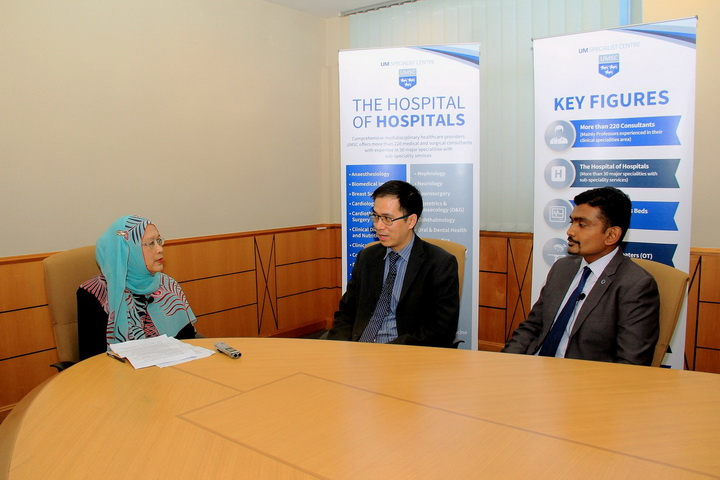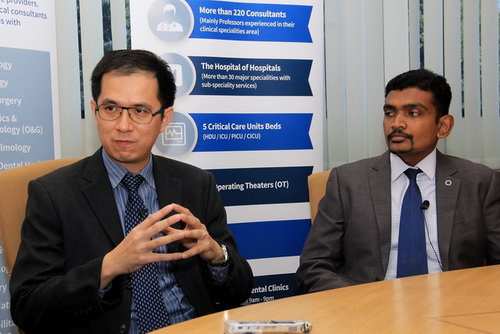Fatty Liver: The Silent Epidemic

(First of a two-part interview)
By Salbiah Said
PETALING JAYA, Oct 10 (Bernama) -- Over the past three decades, Malaysia has become the fattest country in Asia, with nearly half the Malaysian adult population now overweight or obese. Along with obesity comes obesity-related diseases, including fatty liver. The big concern about fatty liver is that it is a silent disease.
What is fatty liver?
According to UM Specialist Centre ( UMSC ) gastroenterologist and hepatologist, Associate Professor Dr Chan Wah Kheong, fatty liver is a condition that is characterised by excess accumulation of fat in the liver, with chronic over-nutrition as the most common cause.
"Our daily energy requirement will gradually increase from the time we are a child to when we are a young adult. From then onwards, our energy requirement starts to decline as we move to middle and older age, plus a more sedentary lifestyle.

UM Specialist Centre (UMSC) gastroenterologist and hepatologist, Associate Professor Dr Chan Wah Kheong (left) and UMSC endocrinologist Dr Jeyakantha Ratnasingam during an interview with Bernama at UMSC recently.
"However, a lot of people continue to eat the same amount of food as they used to eat when they were younger, if not more. This will contribute to obesity and increase in the waistline, accumulation of fat in the liver leading to fatty liver, as well as other diseases, such as diabetes mellitus, hypertension and dyslipidemia (abnormal lipid profile)," he told Bernama during a joint interview at UMSC recently.
UMSC endocrinologist Dr Jeyakantha Ratnasingam says that what triggers the abnormal accumulation of fat in the liver is mainly insulin resistance.
"Basically, the body is not able to use insulin in the correct manner when the person is overweight or obese. And that drives the fat into the liver. People who are most predisposed to fatty liver are those who are obese or overweight," adds Dr Jeyakantha during the interview.
What are the symptoms of fatty liver and is it dangerous?
"Basically, fatty liver does not have any specific symptoms in the early stages. Towards the later stages, a patient may present with complications of cirrhosis, when there is already extensive irreversible scarring of the liver," Dr Chan adds.
He says complications of cirrhosis include bleeding from swollen vessels in the gullet, accumulation of fluid in the abdomen causing swelling, yellow discoloration in the eyes and skin, and other symptoms of liver failure. By then, the quality of life will be affected and the lifespan of the person will be shortened despite interventions.
"Nowadays, we are seeing more and more patients coming (to the hospital) at the later stages of fatty liver as the disease becomes increasingly common in our population," he adds.
"More public awareness must be created. As fatty liver is a silent disease, a person should consider testing for it if he or she is at risk, for example, if he or she is overweight or obese, or has diabetes mellitus," adds Dr Jeyakantha.
How common is fatty liver and who does it afflict?
Dr Chan says fatty liver has certainly reached an epidemic proportion in Malaysia given that one quarter of the adult population suffers from the disease. He cites a recent study which found that nearly 25 per cent of apparently healthy adults who underwent a health check-up were diagnosed with fatty liver. Dr Chan says that not many people are aware of fatty liver despite its high prevalence.
"Fatty liver increases with age. As a person gets older, he or she tends to have fatty liver. In young adulthood and middle-age, it is more common in men. As women reach menopausal age, fatty liver tends to catch up and become as common as in men," he adds.
"Before menopause, the estrogen in a woman's body protects her from fatty liver. But once menopause hits, that protective effect diminishes, with the risk of getting fatty liver becoming similar to that observed in men. The risk of cardiovascular disease also goes up," adds Dr Jeyakantha.
Among patients with diabetes mellitus, the prevalence of fatty liver is even higher, says Dr Chan, adding that it was found that as many as 70 per cent of those who were treated for diabetes mellitus had fatty liver. Persons with diabetes mellitus are also more likely to have more severe fatty liver.
Fatty liver is part of the metabolic syndrome
The metabolic syndrome is a constellation of risk factors for cardiovascular disease and is closely related to obesity. These risk factors include central obesity (defined as a waistline measurement of above 90 cm in men and above 80 cm in women), high blood pressure, dyslipidemia (including high triglyceride and low high-density lipoprotein cholesterol in the blood) and abnormal blood glucose control (including diabetes mellitus). Fatty liver is part of this metabolic syndrome.

UM Specialist Centre (UMSC) gastroenterologist and hepatologist, Associate Professor Dr Chan Wah Kheong showing fibroscan, a medical device to evaluate patients with fatty liver, during an interview with Bernama at UMSC recently.
"Many people are suffering from the metabolic syndrome without them knowing it. They usually do not exhibit any symptoms at all. It is a silent epidemic," Dr Jeyakantha says. He adds that based on the National Health and Morbidity Survey 2015, 17.5 per cent of the Malaysian adult population had diabetes mellitus. "Fifty per cent of the people who were found to have diabetes mellitus in the survey actually did not know that they had diabetes mellitus until the survey was conducted, " he says, noting that most cases of the metabolic syndrome are silent, until it leads to complications.
Suku Suku Separuh
To avoid fatty liver, Dr Jeyakantha recommends 'Suku Suku Separuh' in our eating habit, which is also being promoted by the Ministry of Health. It means having a quarter of carbohydrate, a quarter of protein and half of vegetables and fruits on a standard-sized plate for our meals.
"For carbohydrate, brown rice or whole meal bread would generally be better than white rice or white bread. Protein, egg or fish is healthier than meat. Take lean meat instead of fatty meat. Steamed or soup-based food is healthier than deep-fried food. Once the patient has diabetes mellitus, he or she must cut off sweet drinks completely. By eliminating sweet drinks and taking more water, he or she can cut away a lot of calories which will definitely help with the condition that they have," Dr Chan adds.
"Fructose that comes from sweets, soft drinks, is a big no-no. Cut down on calories, carbohydrates and saturated fats," Dr Jeyakantha says. "The mainstay of treatment for fatty liver is lifestyle modification. Besides the diet, physical activity is also important. The recommended exercise is at least 150 minutes per week or 30 minutes most days in a week. On the amount of weight loss for overweight or obese persons, 10 per cent body weight loss over 6 to 12 months would be ideal and could improve fatty liver," he adds.
Obese children grows into obese adults
On the growing number of obese children in the Malaysian population, Dr Chan says parents should educate their children on healthy eating habits as well as encourage physical activities. "Otherwise, obese children will grow up to be obese adults with all the health problems that come with it," he adds.
"We must also promote healthy eating habits and encourage physical activities in schools. The ministry of education is already promoting these but perhaps more should be done. Definitely a healthy lifestyle would be the way forward. Fatty liver is just part of the big picture of obesity," says Dr Jeyakantha.
-- BERNAMA
For more information click here
HealthEdge
EXCLUSIVE

Pet Vaccination, Public Awareness And Surveillance Key Towards Rabies-free Southeast Asia - Experts
KUCHING, Dec 11 (Bernama) -- The goal of making Southeast Asia free from human rabies can be achieved through a total understanding of the disease, how it can be prevented and responsible pet ownership among communities, say experts.
read more ››IN FOCUS

TAVI KAEDAH BAIK PULIH INJAP JANTUNG TANPA PEMBEDAHAN



